Low temperatures, strong winds and snowstorms, snow cover lying all year round or thawing only for a short time - these are the main conditions that determine life in the polar regions.
Polar deserts
Zones of arctic and antarctic deserts are common in the arctic and antarctic. They formed during the long polar night and extremely low temperatures. Only 10-12 days a year the temperature rises above 0 С, and the topsoil has time to thaw for a short time.
Most of the territory is occupied by glaciers. In ice-free areas, mosses and lichens grow. There are only two types of flowering plants, and in the Arctic there are slightly more of them. Among the arctic species, the polar poppy, snow buttercup, and saxifrage are widespread. In primitive arctic soils, there is almost no humus horizon.
The fauna of the arctic deserts is poor. Only on the rocky coasts in summer the life of noisy bird colonies is in full swing, where guillemots and auk nests, gulls and guillemots nest. On the coasts there are large animals (walruses, seals) that feed on fish and crustaceans. In the Northern Hemisphere, the Arctic is home to large mammals - polar bears. Their main food is fish and seals. V Southern hemisphere In the harsh climate of Antarctica, penguins nesting on coasts in Antarctic oases, where the air temperature is higher than in the surrounding area, feel best.
Tundra
Tundras are common in Eurasia and North America. In Russia, they occupy the second place in terms of area after the taiga. In the Southern Hemisphere, tundra is almost absent.
A typical tundra is a treeless area with low and not always continuous vegetation cover. The main vegetation of the tundra is mosses and lichens. Dwarf birch, polar willow, partridge grass also grow here. They, as if clinging to the ground, form a kind of "pillows". Many shrubs - lingonberry, cloudberry, cranberry - are evergreen. In the short summer, the tundra blooms. The soils of the tundra are often swampy and extremely poor in humus, but rich in semi-decomposed plant remains - peat.
The fauna of the tundra cannot be called diverse. On the shores of tundra lakes, polar geese, swans, and waders nest. Numerous inhabitants of the tundra - lemmings - are the main food of arctic foxes and polar owls.
The largest animal of the tundra is the reindeer. It feeds on lichen lichen. Many animals and almost all birds move to forest zone... The forest-tundra stretches along the border of the tundra in a narrow strip. It is an alternation of areas of tundra and forest.
We have all heard about these plants, but rarely has anyone had the opportunity to see them .. Shall we see?
Arctic deserts (polar desert, icy desert) - a kind of desert with extremely sparse sparse vegetation among the snows and glaciers of the Arctic and Antarctic belts of the Earth. Distributed in most of Greenland and the Canadian Arctic Archipelago, as well as on other islands of the Arctic Ocean, on the northern coast of Eurasia and on islands near Antarctica.
The Arctic desert is home to small isolated areas with mainly crustaceans and lichens and herbaceous vegetation. They look like a kind of oases among polar snows and glaciers. In the conditions of the Arctic desert, there are some types of flowering plants: polar poppy, foxtail, buttercup, saxifrage, etc.
The natural community of the arctic deserts is poor and few in number. This is due to the harsh climate. Vegetation is renewed extremely slowly. The flora of the Arctic desert has just over 60 plant species, which occupy about half of its area.
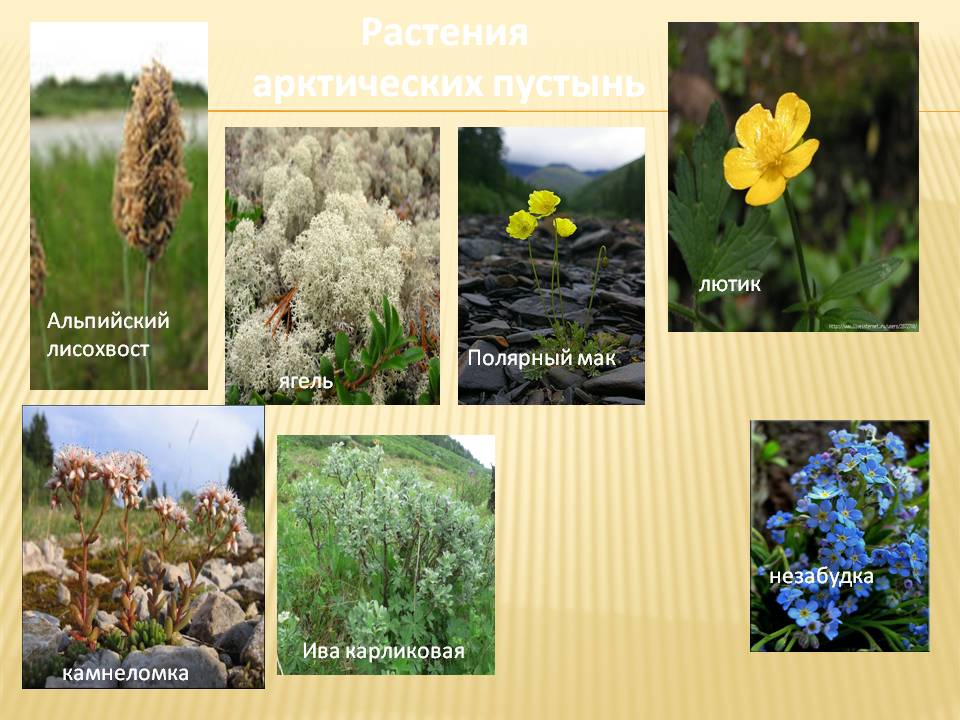
The rest of the space falls on bare, lifeless ground and is covered with rubble, fragments of stones with crusty lichens. The soils are primitive, shallow (1-5 cm), low-humus, with spotty (island) distribution mainly only under vegetation. Areas of open sod vegetation are composed mainly of sedges, some grasses, lichens and less mosses.
Summer eternal ice sometimes they are painted with a pale green color. Microscopic algae grow. The surface of the rocks is covered with lichens. And where there is more heat and less wind, you can see small flowers of starlets, forget-me-nots and saxifrage.
One of the first to bloom is the icy novosiver. It is often referred to as the arctic rose.

In the northernmost part of the region, a variety of polar poppies dominate.
Arctic lichens, the highest rate of photosynthesis in them is observed at temperatures in the range from +5 to +10 C, at a temperature of -5 C, they are able to fix 50% of the possible amount of carbon dioxide, but they can assimilate CO2 at even lower temperatures. For example, alpine stereocoulon and salicornic cladonia absorb carbon dioxide at -24 C, snow cetraria - at -20 C, other species - in the range from -5 to -16 C. This allows lichens to exist in the harshest, extreme habitats of the high Arctic and in the upper belts of tundra mountain systems.
Not only the features of their physiology, but also their structure help tundra plants to adapt to low temperatures. Many Arctic plants form specific life forms - cushion, creeping and pressing to the soil surface, rosette and some others. The more severe the conditions, the higher the proportion of such plants. It is known that the temperature of the soil surface and the surface air layer is significantly higher than at a height of 1.5-2 m (at which data are taken at meteorological stations), and therefore it is easier for a plant to survive near the soil surface. It is also important that the temperature of the organs inside dense pillows and tufts pressed against the soil, especially dark-colored ones (in the Arctic, by the way, many plants are characterized by an intense violet-purple color of leaves and stems, which they acquire due to the content of a special pigment in the cells - anthocyanin) , can exceed the ambient temperature by 10 C or more. So, according to observations in North Greenland, it was noted that at an air temperature of -12 C inside the saxifrage curtain, it was +3.5 C, and even +10 C in moss cushions. Interestingly, dark-colored plants begin to grow and develop under the snow, called "snowy greenhouses", almost half a month earlier than other plants.
Creeping tufts and cushions are also important adaptations to harsh winter conditions. Thick "rugs", coupled, as a rule, with dead leaves, stipules, peduncles and shoots remaining for the winter, retain snow well within the curtain, which, firstly, protects flower and vegetative buds from low temperatures, and secondly, protects wintering parts of the plant from damage and excision by needles-crystals of ice and snow, carried by stormy winter winds.
Crowberry
Voronika, or shiksha, like many other tundra plants, is one of the shrubs. But this shrub is unusual: the branches of the plant are very similar to the branches of some kind of coniferous tree, as they are covered with small leaves resembling needles. However, the crow is a flowering plant, and its leaves only look like needles in appearance. In fact, these are narrow, not completely closed tubes (the edges of the leaves are rolled down and sometimes almost touching). The stomata are located on the inner side of the tubules. This structure of the leaf helps to reduce evaporation. Long, highly branched shoots of crows spread along the ground, their ends rise up.
Voronika is an evergreen shrub with leaves that do not fall off for the winter. However, in the fall, with the onset of cold weather, they darken, acquiring a violet-black color. The crowberry blooms early - as soon as the snow melts. Its flowers are small, inconspicuous, usually located singly in the leaf axils.
Northernmost natural area the planet is an arctic desert located in the latitudes of the arctic. The territory here is almost completely covered with glaciers and snow, sometimes there are fragments of stones. Here most of the time winter reigns with frosts of -50 degrees Celsius and below. There is no change of seasons, although during the polar day there is a short summer, and the temperature during this period reaches zero degrees, without rising above this value. In the summer it can rain with snow, there are thick fogs. There is also a very poor flora.
Due to such weather conditions, animals of the Arctic latitudes have high level adaptation to this environment therefore they are able to survive in harsh climates.
What birds live in arctic deserts?
Birds are the most numerous representatives of the fauna that live in the zone of the arctic deserts. There are large populations of rose gulls and guillemots, which feel comfortable in the Arctic. The northern duck, the common eider, is also found here. The largest bird is the northern owl, which hunts not only other birds, but small animals and young large animals.
Pink seagull
Common eider
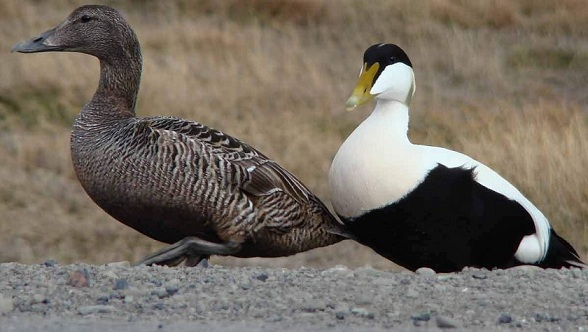
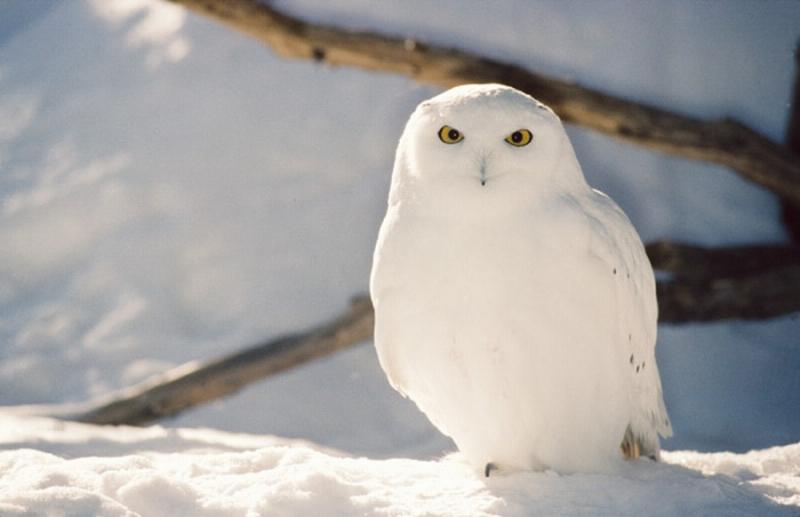
What animals can be found in the Arctic?
Among the cetaceans in the Arctic desert zone, there is a narwhal, which has a long horn, and its relative, the bowhead whale. Also, there are populations of polar dolphins - beluga whales, large animals that feed on fish. Even in the arctic deserts, killer whales are found hunting various northern animals.
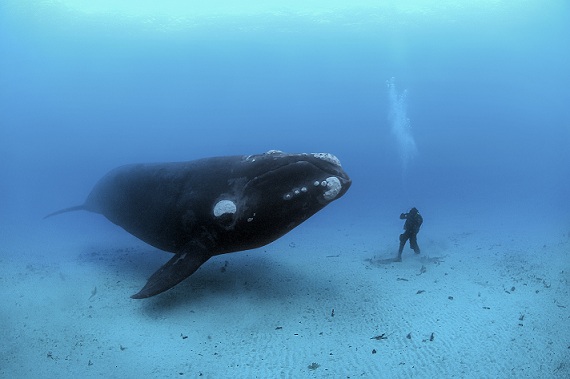
There are numerous populations of seals in the Arctic desert, including harp seals, mobile ringed seals, large sea hares - seals, 2.5 meters in height. Even in the vastness of the Arctic, you can find walruses - predators that hunt smaller animals.
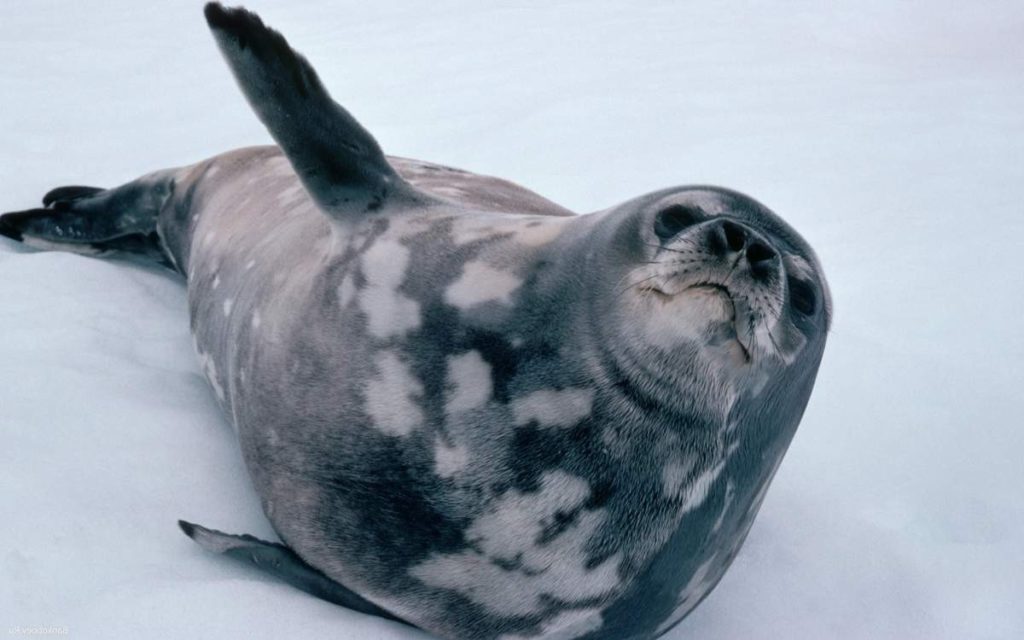
Among the land animals in the Arctic desert zone, polar bears live. In this area, they are excellent at hunting both on land and in water, as they dive and swim well, which allows them to feed on marine animals.
White bears
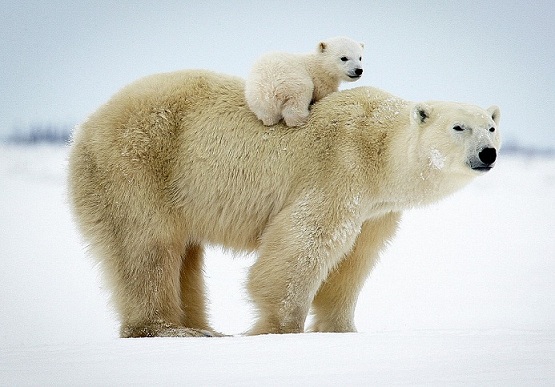
Another severe predator is the arctic wolf, which does not occur singly in this area, but lives in a flock.
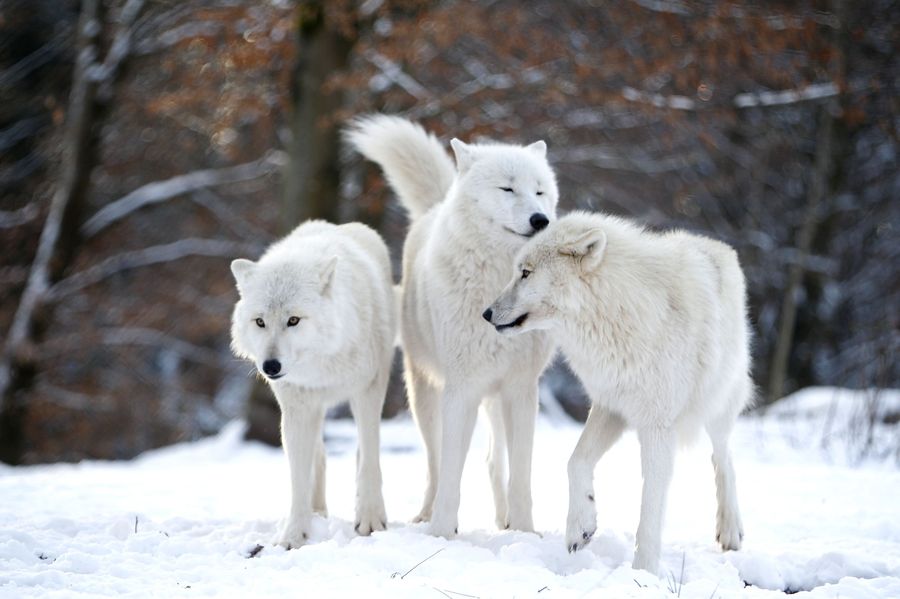
Such a small animal as the Arctic fox lives here, which has to move a lot. Lemming can be found among rodents. And, of course, there are large populations of reindeer here.
Arctic fox
![]()
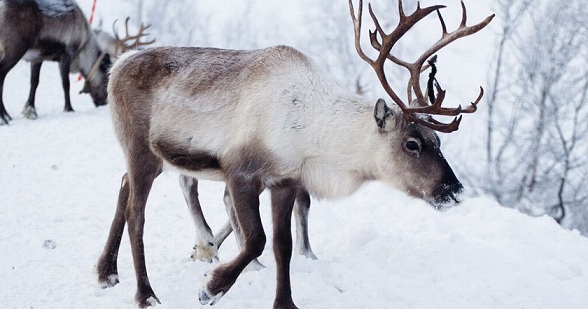
Adapting animals to the arctic climate
All of the above species of animals and birds have adapted to life in the arctic climate. They have developed special adaptive capabilities. The main problem here is keeping warm, so in order to survive the animals must regulate their temperature regime... Bears and arctic foxes have thick fur for this. This protects the animals from severe frost. Polar birds have loose and tight plumage. In seals and some marine animals, a fatty layer forms inside the body, which protects from the cold. Particularly active defense mechanisms in animals are manifested with the approach of winter, when frosts reach absolute minimum... In order to protect themselves from predators, some representatives of the fauna change the color of their fur. This allows some species of the animal world to hide from enemies, while others can successfully hunt in order to feed their offspring.
The most amazing inhabitants of the Arctic
According to many people, the most amazing animal in the Arctic is the narwhal. This is a huge fish that weighs 1.5 tons. Its length is up to 5 meters. This animal has a long horn in its mouth, but in fact it is a tooth that does not play any role in life.
In the reservoirs of the Arctic, the polar dolphin, the beluga, is found. He only eats fish. Here you can also meet the killer whale, which is a dangerous predator that does not neglect either fish or larger marine life. Seals live in the arctic desert zone. Their limbs are flippers. If on land they look awkward, then in water fins help animals to maneuver at high speed, hiding from enemies. Relatives of seals are walruses. They also live both on land and in water.
The nature of the Arctic is amazing, but due to the harsh climatic conditions not all people want to join this world.
The sun's rays only glide along their surface, giving little heat, because the sun never rises high here (Fig. 2).
Rice. 2. Arctic Sun ()
The Arctic has a very harsh climate: snow and ice lie almost all year round, winters are very long and frosty (up to -60 °), hurricane winds blow, and a blizzard rages for several weeks in a row. From mid-October, the sun is no longer visible - the long polar night begins (lasts up to 6 months). Sometimes during the polar night there are polar lights, which last from several minutes to several days and are so extensive that their light is sufficient even for reading (Fig. 3).
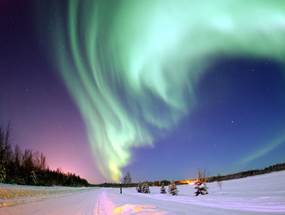
Rice. 3. Aurora Borealis ()
At the end of February the sun appears and the day begins to arrive. And from mid-May to mid-June, the sun does not hide at all - the polar day begins. But even at this time, the temperature rises only a few degrees above zero.
The islands are so poor in vegetation that they are called arctic deserts... On the stones meet moss, lichens, polar poppy and some other plants (Fig. 4-6).
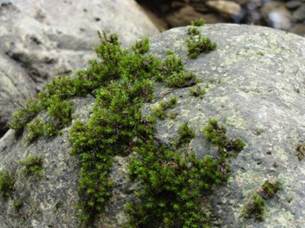
Rice. 4. Mosses on a stone ()
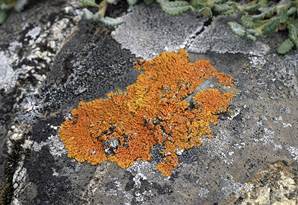
Rice. 5. Lichens on the stone ()
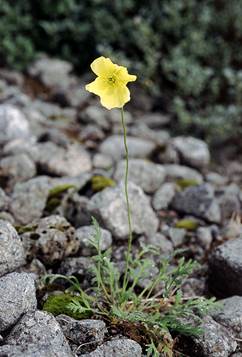
Rice. 6. Polar poppy ()
All plants here are dwarfs, their height is no more than 10 cm, only polar willow reaches 1 m (Fig. 7).
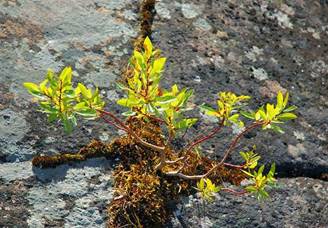
Rice. 7. Arctic willow ()
But all plants, protecting themselves from the cold and wind, are forced to cuddle to the ground.
The sea feeds all the inhabitants of the ice zone. In water rich in oxygen and carbon dioxide, they actively reproduce algae and crustaceans- the first link in the food chain arctic zone(fig. 8).

Rice. 8. Algae, crustaceans and other inhabitants of the ocean ()
They feed on fish and birds. The birds gather in large flocks, settle on the rocks, and, despite the tightness and size of the flock, each bird unmistakably finds its nest (Fig. 9).

Rice. 9. Nesting guillemots ()
Guillemots- noisy birds that nest on sheer cliffs where no animal can reach (fig. 10).
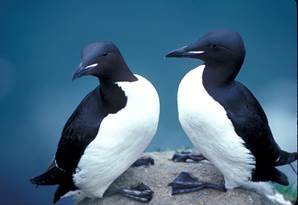
Guillemots hatch only one cone-shaped egg (this shape prevents the egg from falling from high rocks). When the chick grows up, the guillemot throws it into the water, where its adult life begins: guillemots are excellent swimmers and divers (in the water they develop speeds up to 20 km / h, reaching a depth of 140 m).
Seagulls also adapted to the conditions of the Arctic: they fly well, swim well, but dive poorly (Fig. 11).
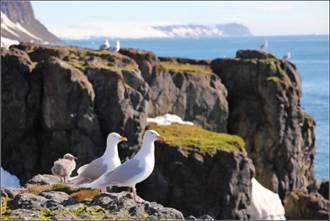
On some islands, you can see a huge number dead ends(fig. 12).

These are beautiful silent birds with an unusual beak. For living, they choose islands with a thick layer of peat, in which they dig their nests with the help of clawed paws and beaks. A dead end is an excellent getter: it can stay under water for up to 30 seconds, chasing fish, and bring up to 10 fish to the nest at a time.
Another food chain is algae - crustaceans - whales(fig. 13).

These huge animals are perfectly adapted to life in the ice zone: a waterproof hide and a thick layer of fat under it protect them from the cold.
Seals- one more inhabitants of the Arctic, live both on land and in water (Fig. 14).
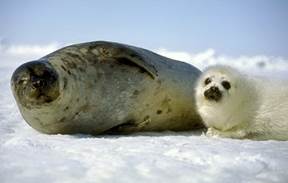
They are great swimmers. They need up to 16 kg of food per day. At the end of winter, seals give birth to snow-white cubs - seals. The white color helps kids to hide, disguising themselves as snow in order to escape from enemies, primarily from a polar bear. And adult seals escape from their main enemy in the water, because on land they are slow and clumsy.
Polar bear called the king of the Arctic, the great traveler and hunter (Fig. 15).
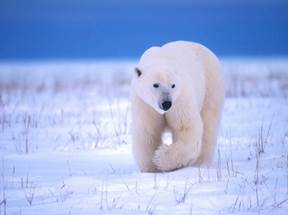
Rice. 15. Polar bear ()
This animal perfectly adapted to life in the ice zone: it is fast and agile on land and in water, strong, it has an excellent sense of smell, thick white hair and wide paws with sharp claws. Like all inhabitants of the Arctic, he has small ears - so as not to freeze. For the winter, female mothers lie in snow dens, where cubs are born to them (most often there are two cubs, they are small, the size of a mitten). The mother bear feeds and warms them. In the spring, the cubs will leave the den, but for another two years the bear will teach her cubs to fish, hunt seals and much more (Fig. 16).
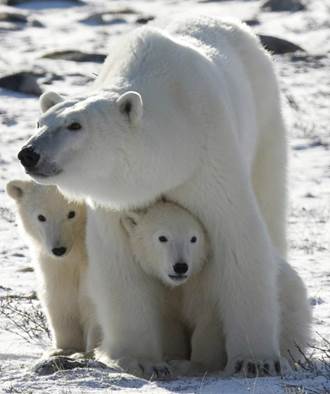
Rice. 16. Polar bear with cubs ()
The fauna of the Arctic is unique. A nature reserve was created on Wrangel Island - here are the largest concentrations walruses(fig. 17).
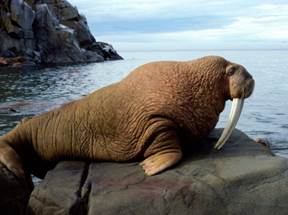
Walrus tusks- a universal weapon in the production of food and a weapon in defense from the enemy, as well as an insignia (who has the largest and most powerful tusks, he is the main one). There is a thick mustache on the face of the walrus - vibrissae- with the help of which they find food at the bottom of the sea (Fig. 18).
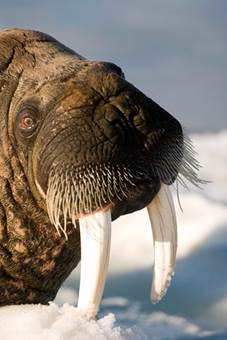
Rice. 18. Vibrissae on the walrus face ()
You can also see in this reserve musk ox(fig. 19).
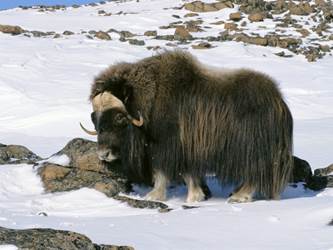
Rice. 19. Musk ox ()
Once they lived on the territory of Russia, but then they disappeared, and scientists brought them to Wrangel Island from North America(this is how rare and endangered species of animals are preserved).
This reserve is also called the maternity hospital of polar bears - bears come here from all over the Arctic, scientists count up to 250 dens per year.
For many years, the Arctic has been attracting people who, risking their lives, in extreme conditions, explore its expanses, make maps (Fig. 20).
Bibliography
- Vakhrushev A.A., Danilov D.D. The world around you 3. - M .: Ballas.
- Dmitrieva N.Ya., Kazakov A.N. The world around us 3. - M .: Publishing house "Fedorov".
- A.A. Pleshakov The world around us 3. - M .: Enlightenment.
- Geo-site.ru ().
- Biofile.ru ().
- Do.gendocs.ru ().
Homework
- Write a short quiz (6 questions with three possible answers) on the Arctic Desert Zone.
- Prepare small message about one of the animals in the Arctic.
- Think how you would change appearance and the habits of a brown bear, if he lived in a zone of arctic deserts.
- * Using the knowledge gained in the lesson, compose a small (10 questions) crossword puzzle on the topic "Arctic".
The Arctic Desert is the northernmost natural area. Despite the unfavorable growing conditions, there is still an insignificant part of the vegetation. Today we will consider typical plants of the Arctic deserts of Russia, that is, they are often found in the conditions of this region.
Peculiarities climatic zone Arctic
The climate of the Arctic desert can be described in two words - eternal winter. Although theoretically there is summer, the temperature at this time of the year does not rise above +5 degrees. In the summer in the Arctic, snow melts a little, due to which the earth is at least slightly moistened. It is interesting that the soil layer is thawed out over the summer by only 40 cm in depth, nothing more. Winter lasts almost constantly, and the air temperature here usually fluctuates within -35 degrees, but often drops to -60.
The land in this area is practically not illuminated by the sun and does not warm up. In addition, there is little rainfall here. Despite the severity of this climatic natural zone, there is still vegetation here. It is difficult to call the local flora rich, but still some plants are so hardy that they can survive in such difficult conditions. Let's get to know them.
What plants grow in arctic deserts?
I would like to note right away that you will not find shrubs and trees in the Arctic. The wind is too cold, so the plants cannot "stick out above the ground" and remain alive. So mosses and lichens predominate there, as well as various algae. Almost half of the Arctic desert is not covered with vegetation at all, but consists of rocky soil and ice. The soil as such, even if it is found in the Arctic desert, is covered with iron and manganese oxide on almost the entire surface layer. That is why the earth here has a characteristic reddish-brown hue. Soil islands are usually occupied by sparse vegetation. The land near the ocean contains salt, so it is deserted.
Mosses and lichens
Almost 3 percent of the total area of the Arctic desert is occupied by mosses and lichens. They "settle" on protected from strong wind plots. In the northernmost part of this natural zone, only some species of lichens can grow - informal, cladonia and parmelia. Sphagnum mosses can also be found here. Where the arctic desert borders the tundra, the number of mosses and lichens increases significantly. In this strip, this vegetation already covers 60 percent of the soil.
The highest representatives of the flora of the Arctic deserts
In addition to mosses and lichens, some of the highest representatives of the flora have adapted to the extreme conditions of existence in the Arctic. They are found in places well protected from the wind, and their distribution is focal. Some desert ice plants even delight with their short flowering. All vegetation in this area has distinctive features- a root system that penetrates shallowly into the ground and is short. Let's talk about them in more detail. What kind of Russian plants are they that could grow here?
Poppy polar
Polar poppy is a perennial plant found in the Arctic deserts of Russia, mainly in the Urals (polar regions), in Yakutia and the Magadan region. This representative flora The Arctic does not reach a height of more than 15 cm. It grows on stony soils. During a short summer, it pleases with its bright yellow and orange colors.
Arctic pike
A herbaceous plant with a hardy root system, which is a low (up to 30 cm in height) panicles with leaves at the base. The deciduous part is green, above the soil layer, at the roots, there are many leaves. With the onset of winter, they die off and form a thick layer of brown scales around the plant. The plant produces spikelets up to 15 cm long, erect, dense.
Arctic buttercup
This plant prefers humus-rich soil, so it can be found near bird colonies or near lemming burrows. Buttercup, like all representatives of the Arctic flora, is a stunted plant. It blooms with yellow flowers, either single, or collected in inflorescences.
Snow saxifrage
Snow saxifrage is a groundcover perennial plant that grows in the Arctic desert. Reaches a height of no more than 20 cm, covers the entire free space of the soil with a small-leaved carpet. During flowering, the snow saxifrage is covered with small white flowers resembling stars. Due to its frost resistance and unobtrusive beauty, the plant is successfully used as a decoration for alpine slides.
Sedge
The herb of the Sedge family is widespread almost everywhere, it can be found on almost all continents. In the Arctic deserts of Russia, it grows both in the Arctic and in areas bordering on tundra forests. Sedge is completely unpretentious, and due to its ability to withstand low temperatures it is often used in landscape design. This herbaceous plant grows on stony soils and rocky slopes. Some species of this herb are listed in the Red Book as endangered.
Plants of the Arctic deserts of Russia are not so numerous, but the variety of species of grasses, plants and shrubs increases with approaching the tundra zone. In this part, the flora becomes much richer. All arctic herbs are amazing - being in harsh conditions, they delight us with their resilience and delicate beauty, which even eternal ice cannot destroy.




